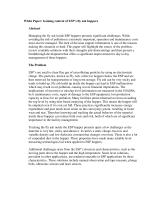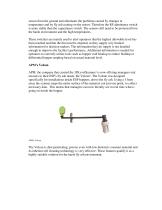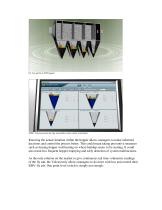
Catalog excerpts

White Paper: Gaining control of ESP’s fly ash hoppers Abstract Managing the fly ash inside ESP hoppers presents significant challenges. While avoiding the risk of pollution is extremely important, operation and maintenance costs must also be managed. The lack of decision support information is one of the reasons making this situation so hard. This paper will highlight the source of the problem, review available solutions with their strengths and shortcomings and then present a breakthrough development that offers a significant improvement for day to day management of these hoppers. The Problem ESP’s are used to clean flue gas of air polluting particles by using an electrostatic charge. The particles, known as Fly Ash, collect in hoppers below the ESP and are then removed for transportation or long term storage. Fly ash can be very sticky and tends to build up. Fly ash build up inside the hopper can lead to ESP malfunctions which may result in air pollution, causing severe financial implications. The implications of incorrect or missing level information are measured in the $10,000s, be it maintenance costs, repair of damage to the ESP equipment, lost production capacity or fines for air pollution. Many facilities protect themselves from exceeding the top level by using time based emptying of the hopper. This means the hopper will be emptied even if it is not yet full. These practices significantly increases energy expenditure and puts much more strain on the conveying system, resulting in faster wear and tear. Therefore knowing and tracking the actual behavior of the material inside these hoppers can reduce both costs and risk, both of which are of significant importance to the facility management. Tracking the fly ash inside the ESP hopper presents quite a few challenges as the material is very hot, sticky and abrasive. It carries a static charge, has low and variable density and low dielectric constant that changes over time. There is also a lot of suspended dust in the hopper. These properties have made many reliable levelmeasuring technologies fail when applied to ESP hoppers. Additional challenges arise from the ESP’s structure and characteristics, such as the moving parts above the hopper and the high temperature. Some level solutions, prevalent in other applications, are rendered unusable in ESP applications by these characteristics. These solutions include manual observation and tape measure, plunge bobs, ultrasonic sensors and laser sensors.
Open the catalog to page 1
Current Solutions Nuclear gauges use a radioactive source mounted outside one side of the hopper transmitting to a receiver on the other side. The fly ash present inside the hopper blocks the radiation from the source to the receiver, thus the level is determined. Since these nuclear switches are mounted outside the hopper they are protected from the harsh environment created by the fly ash. These gauges have several shortcomings including the fact they only measure the high point of the material, leaving managers with insufficient information about the material inside the hopper. For...
Open the catalog to page 2
sensor from the ground and eliminates the problems caused by changes in temperature and by fly ash coating on the sensor. Therefore the RF admittance switch is more stable than the capacitance switch. The sensors still need to be protected from the harsh environment and the high temperatures. These switches are mainly used to alert operators that the highest allowable level has been reached and that the bin must be emptied, as they supply very limited information for decision makers. The information they do supply is not detailed enough to improve the facility's performance. Additional...
Open the catalog to page 3
APM's Volcan presents the flay ash profile on the control workstation Knowing the actual situation within the hopper allows managers to make informed decisions and control the process better. This could mean taking preventive measures such as turning hopper wall heating on where buildup seems to be starting. It could also mean less frequent hopper emptying and early detection of system malfunctions. As the only solution on the market to give continuous real time volumetric readings of the fly ash, the Volcan truly allows managers to do more with less and control their ESPs' fly ash. One...
Open the catalog to page 4
Conclusion ESP hoppers present managers with unique challenges. Making the right decisions in order to optimize the tradeoff between risks and costs is a challenge and without the correct information it becomes even more problematic. The new Volcan tracking solution offers managers the full set of data needed for making informed decisions, allowing them to maintain low costs and low risk levels concurrently.
Open the catalog to page 5All APM Automation Solutions Ltd. catalogs and technical brochures
-
3D MultiVision Software
4 Pages
-
3DLevelManager
52 Pages
-
3DLevelScanner HC
4 Pages
-
3DLevelScanner HT
4 Pages
-
3DLevelScanner S / M / MV
8 Pages










